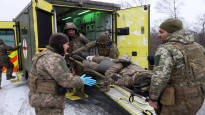Twenty Ukrainians, both civilians and soldiers, have received treatment in Finland.
Russia’s devastating attack on Ukraine has led to a major operation that has helped transport Ukrainians to hospitals across Europe.
A total of a couple of thousand seriously injured Ukrainians have ended up in European treatment centers through the European Union’s rescue service mechanism.
Of them, twenty Ukrainians have received treatment in Finland, says the Ministry of the Interior. The patients have been both civilians and soldiers. Germany has received the most patients, six hundred.
From the other Nordic countries, Denmark has taken in about a hundred patients, and Sweden, seventy. A hundred people in need of help have also been transported to Lithuania. Large recipient countries have been Spain and Norway, to both of which a couple of hundred patients have been transported.
All EU member states and, among others, Iceland, Norway, Serbia, Montenegro and Turkey participate in the rescue service mechanism.
The best treatment, where speed is the key
On the other side of Finland, the emergency center of the Hus group acts as the national medical care coordinator appointed by the Ministry of Social Affairs and Health, to which information about patients in need of treatment is provided by the EU rescue service mechanism.
– We receive a list of patients who are offered for treatment. We will discuss which central or university hospital would be able to help. The patients are then referred to these hospitals, says the security and preparedness director of the Hus group Aaro Toivonen.
He does not reveal the patient’s injury profile or number in more detail, but says that the patients receive the best possible treatment in Finland.
In Finland, clearly fewer Ukrainian patients have been treated than in natural reference countries, i.e. Norway, Sweden and Denmark. This is mainly explained by two things, says the special expert of STM’s preparedness unit Lasse Ilkka. The first is the shortage of nursing staff, which was complicated by last year’s labor disputes.
– We had a capacity problem, because there was, among other things, the labor struggle situation of the healthcare personnel, which affected the issue. In any case, compared to many comparison countries, our personnel situation has been quite difficult.
According to Ilka, another reason for the small number of patients in Finland is that the desire to help in different countries is so great.
– In recent months, we have had situations where we have announced that we can accept patients, but they have already had time to get treatment elsewhere.
